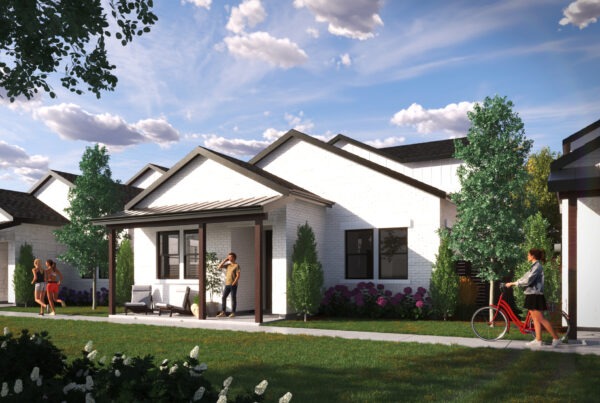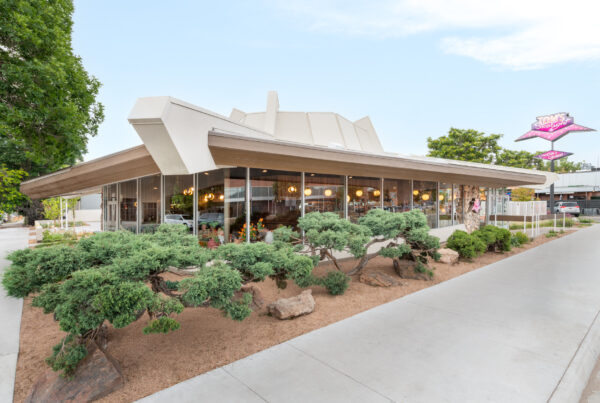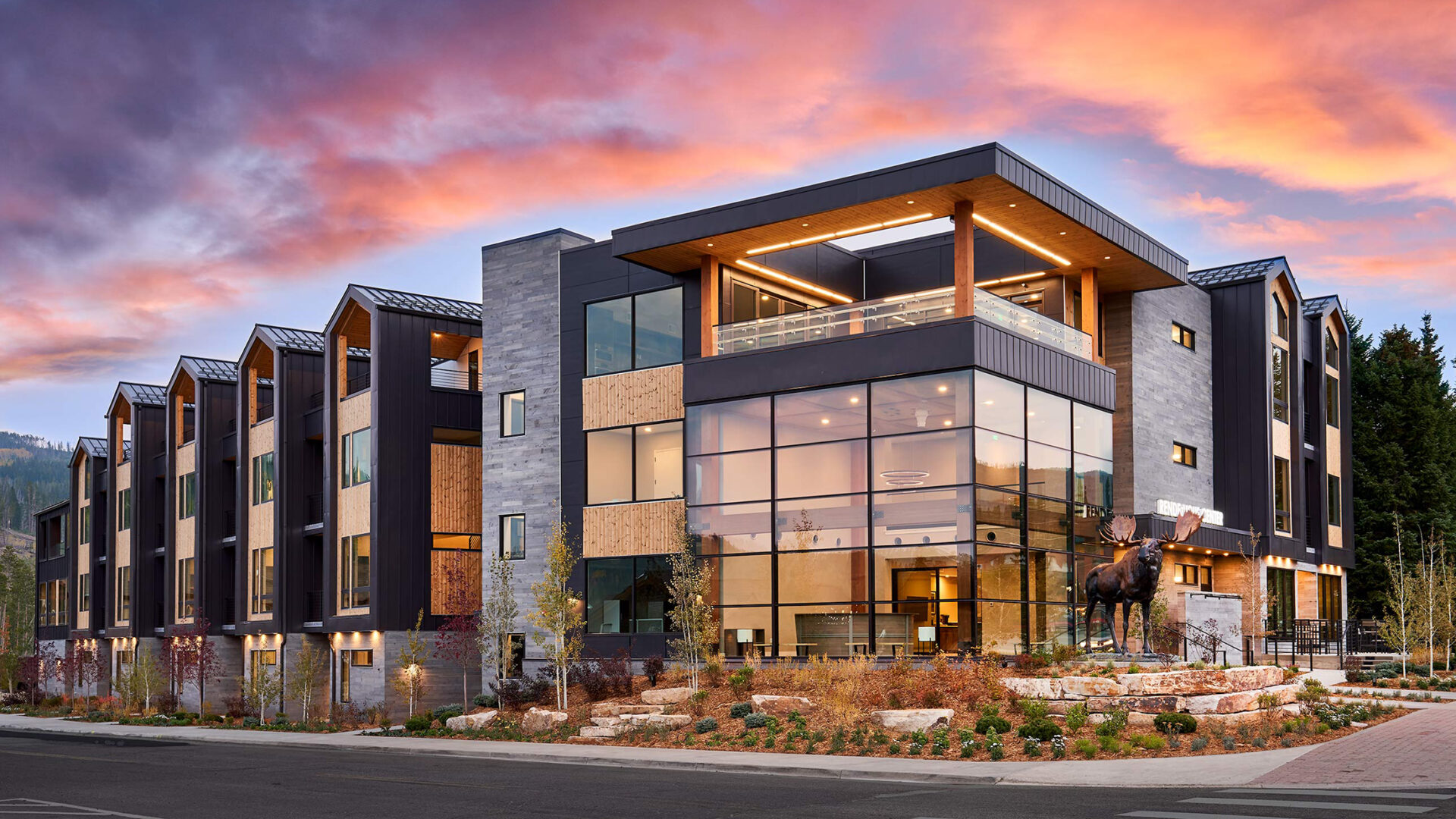Humanity is experiencing the most significant health challenge to our existence in a century. As COVID-19 spreads and disproportionately affects older adults, the design of senior living communities is being impacted and will be for years to come.
As architects, we can design environments that enable us to be smarter about how we live together. We can work alongside our healthcare workers to lead society into a new world where we are not afraid to live with the threat of infectious diseases and, at the same time, experience purposeful lives.
The Impact on Senior Living Communities
The foundation of senior living communities is to provide a setting for health, social connection and safety – key premises that are being challenged by COVID-19. As of April 23, COVID-19 has claimed more than 10,000 lives in long-term care facilities, including nursing homes and assisted living, across 23 U.S. states, according to a Kaiser Family Foundation analysis. That number is inclusive of residents and staff members. Since the mortality rate for seniors is so high, extra precautions are needed to safeguard this vulnerable demographic. The response to the virus is to require “social distancing” or quarantining. What does this look like?
- No visitors except at the end-of-life/hospice.
- No on-site tours are being given to prospective residents. Communities are leading computer “virtual” tours.
- New residents are screened medically and quarantined for 14 days.
- Contacts with families are limited to telephone, Facetime, Skype, etc.
- Meals mostly taken in each individual’s apartment.
- Gatherings, if allowed, are limited to five people with 6-foot minimum distancing.
- Daily temperature readings of residents and staff since fever is a principal symptom.
Until a vaccine is available, some sort of physical quarantining is likely to be the new normal for senior living communities. However social distancing is not the answer. Human connection is key to the success of the aging services world.
And yet, even in the face of this pandemic, senior living is still viewed as a good option, especially for elders living alone due to the high level of services and engagement these communities provide. They eliminate the need for older adults to expose themselves to the virus by going to the pharmacy, the bank or the grocery store. These communities have professionals who carry out the highest standards of cleanliness, maintain social activities, balance nutritional needs and provide immediate health care.
In addition to severely impacting residents, the virus also is having profound effects on the operations of senior living communities. It has eroded several profit centers including health care and food service, the costs of which have risen alarmingly in the past two months. These cost increases are largely attributable to the mandatory purchase of personal protective equipment, the addition of computer systems to manage the health care for residents and seniors taking more meals than previously provided by their communities.
Architectural Solutions
Providers across the U.S. are being forced to radically alter their existing operations to manage this crisis and, as a result, Kephart envisions that the design of senior living communities will be forever changed. Architects will be designing with these situations in mind. We’ve identified several key areas of focus, especially for new construction.
Settings for physical distancing incorporated into buildings:
- Widen corridors to 10 feet so residents and staff can comfortably pass each other without encroaching on the 6 feet of recommended spacing for social separation. When not in a pandemic situation, this extra space could be used to accommodate informal seating.
- Build more meeting rooms that allow family and friends to visit with residents at the proper, safe distance.
- Create isolated “visitation” rooms where guests can enter directly from the outside – without stepping into the main building and bringing contaminants inside – and can see their resident friend or family member through a picture window and communicate via an intercom system.
- Provide more opportunities for visits to take place safely outside of the building.
- Air filtration and purification will become more important in senior living design. Create “isolation” rooms that quarantine the air and water to safeguard all residents.
- Adopt designs in which there are several small “neighborhoods” of residents. Each could have 12 to 20 private bedroom/bathroom suites around a central area where residents can dine, socialize, exercise, and sleep. This allows for easier separation of residents, and this model can be applied to assisted living, skilled nursing, and independent living populations.
- Large rooms, which have been set up for concerts, lectures, films, and parties, will have to be rethought. When the pandemic threat ends, it will again be possible to have larger assembly rooms, though it would make sense to have them be able to be subdivided into smaller spaces with moveable walls.
- Rethink elevators. They don’t allow more than a couple of elders to travel together while maintaining a safe distance from one another. The size of the cab will need to be larger or additional elevators will need to be added.
Shift in focus from a resort hotel-style of design to home-style living.
The “cruise ship” model for senior living was already encountering rough waters prior to the pandemic. Now it is sinking. The new model for senior living will put less importance on expensive and often unused amenities, and more emphasis on providing a personalized experience; one that focuses on health, well-being and purposeful living for the residents.
Improvements to the Design of Residential Units
- Outdoor accessibility will be increased as the virus has shown us all how important it is to have access to the outdoors. The ability to have direct connectivity to a terrace or even a Juliet balcony becomes very important to the well-being of residents. New construction will add more balconies.
- Unit size will be increased, since being cooped up in an efficiency apartment for a long period of time is too confining. The addition of a larger dining area, a den or hobby room will be beneficial.
- Activate the corridors. One way to do so is to create a front porch experience in hallways where residents can comfortably sit outside of their units and visit with neighbors across the hall or even enjoy a corridor concert.
- Materials will be antimicrobial or easily cleanable. In the future, providers will look to make flooring, accessories, countertops, cabinets, doorknobs, light switches, handrails and doors more resistant to pathogens like COVID-19. Furniture with advanced germ-fighting properties will become common.
- All furniture, appliances and high-touch surfaces will be regularly cleaned with ultraviolet germicidal irradiation equipment.
- Providers will eliminate shared rooms and transition to only offering private rooms with private bathrooms.
Changes to Food Service
- “Room service” and “grab-and-go” meals will be a fact of life for the operation of communities. While people crave to dine together, there will be a long-term carryover of food being delivered directly to many residents.
- Dining rooms will be designed to operate even at 50% occupancy so that residents can sit together at a safe social distance. This will require an operational shift to have several “sittings” for meals.
- Salad bars, soup bars and buffets will be eliminated as many viruses pass through the air. Also, these setups operate with people taking turns to share serving utensils.
- Kitchens will have to be redesigned to facilitate a higher level of cleanliness and disinfection.
Using Technology to Provide Socialization and Health Care
- This will require a robust computer and internet network with lots of “bandwidth.” • Inter-community communications, such as TV stations that are specifically hosted by the local community for purposes of information, delivery of programs and news, will become more common.
- Communications with family and friends using networks (i.e. Skype, Zoom, FaceTime, etc.) will become prevalent.
- The use of telemedicine will increase. Bluetooth low-energy devices that measure vital signs allow caregivers to better monitor residents’ conditions and respond quickly in the event of sharp changes and medical emergencies. They also give residents greater ability to manage their own care, promoting wellness through better nutrition, exercise and reminders for medication management.
Touchless Operation
Since viruses like COVID-19 can be spread by a person’s hands, architects will specify a variety of appliances that are already in use:
- Touchless technology that registers personal temperatures when people walk in the door. This would reduce staff time for taking temps and documenting.
- Touchless hand washing, antibacterial and drinking water stations. Locate them liberally throughout public spaces such as entry vestibules, corridors, lounges, gathering spaces, dining areas and wellness rooms. Include them in resident rooms too.
- Entrance doors on buildings will all be automatic, as well as doors into all interior rooms and bathrooms.
- Facial recognition scanners will become more widely used for security purposes.
- Restrooms in all public buildings will be touchless from the front door, to the toilet room door, to the sink, to the paper towel rack. Note that paper towels are considered more sanitary than air dryers, which circulate potentially contaminated indoor air.
- Refrigerators, microwaves, doors and coffee pots will be redesigned to be as touch free as possible.
- Libraries in senior living communities will transition almost completely to paperless mediums. Books and news sources like magazines and newspapers will become completely electronic.
- Ultraviolet disinfecting systems for cell phones, tablets and other high-touch items.
Seniors working longer. The virus has shown that seniors will fill their time with purposeful activities. Baby boomers will choose to do consulting and other engaging work, rather than just retire outright. It will make sense to provide some office spaces in senior living communities, outside of the residences. These can be modeled after the popular work share setups where residents can reserve an office on an as-needed basis, with access to the internet, copiers and even a conference room.
Architects can play a significant role in providing the solutions to come out of this crisis into a much happier place. Our elders are at the most risk, so we should consider committing our resources and talents to honor them by providing innovative approaches for improving senior living environments.






